

Vincent de Rijk is perhaps one of the most well known architectural model makers in Europe. He graduated from the Design Academy Eindhoven, with an industrial design degree. His proximity to the architectural scene in Rotterdam, at around the time when now-famous firms were emerging, has resulted in a multitude of rich collaborations that continue to this day.
Vincent has developed techniques of model making dealing with plastics, specifically the casting of polyester in which he is the foremost expert. His education and practical skills along with a keen understanding of the aims and ambitions of architects have made him a sought-after, and coveted partner on all important competitions and commissions throughout Europe & North America.
Tomek Bartczak: One of the first stories that I heard about you was from Barendt Koolhaas. He told me that you were involved in a model airplane club and you were the youngest member by a few years. So I guess model-making has been an interest of yours for a while now?
Vincent De Rijk: Yes, but always by accident more or less. When I was young, I had some classmates and they were into this airplane building, and then I saw that and said that's nice and I want to go to that model-making club! I was ten years old, and you had to be twelve to enter. It was not that I was especially talented. The nice thing was (looking back on it) that I was already into production more or less and made a whole squadron of Spitfires instead of one Spitfire and then another model.
TB: Yes, Barendt mentioned that also. He said that people were really confused by that. Did you always know you wanted to make architecture models?
VDR: Architecture models just came naturally when we moved to Rotterdam. We were starting up our own workshop with a group, and basically you always need some work on the side when you're starting out, so that's how it happened. Franz (Parthesius), my friend and colleague, who is now a photographer, was more in contact with the architects. They were people that he knew, and we started helping them out with competition work - virtually unpaid in the beginning.
TB: Do you see a lot of cross-over with your work, between industrial design and model-making? Figuring out processes for one and then applying it to the other where possible?
VDR: Yes, more or less, because in my workshop, I always was trying to develop my own techniques, and casting of resin was one of them, also plaster casting, (mostly casting processes). Processes that are more suitable for the workshop rather than industry. So I had experimented with these processes, and the nice thing was that it didn't make any difference whether you made a bowl or a model in the end - it's the same way of thinking with those techniques. That's also what Rem (Koolhaas) saw in the beginning. He saw the bowls we were making with the resin, and he said you should use those techniques for model making. It was not directly his idea, but he also saw the connection...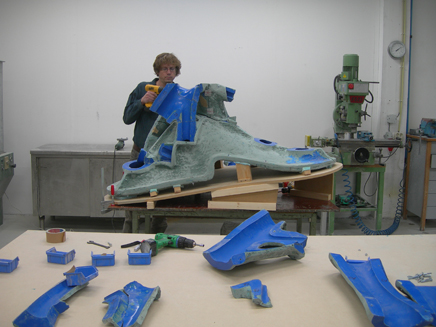
De Rijk with a multi-piece epoxy mould for casting a very complex polyurethane chaise longue .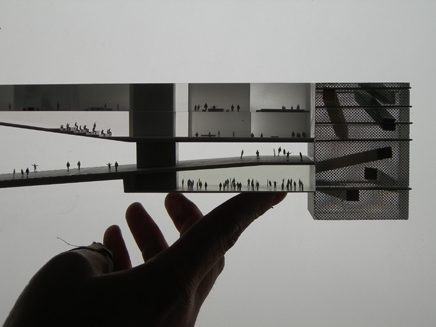
Polyester model with metal mesh and scale people cast within.
TB: That leads into my next question: how do you approach a model job? How do you visualize the finished project? You once told me that you don't want to know too much about the building project, what it's about, or what the philosophy of the design is. Can you elaborate on that?
VDR: Well, I'm only concerned with the main features. There's a whole team of architects that know everything about the building, and they'll make sure that whatever is important will be in the drawings, and in the description they give me.
For me, it's important to find the simplicity in the project and to find what the main characteristic or feature is...something that you can take away from it. Rem is also able to do that in his descriptions. If he talks about a building, he can make a really simple description about it...and that's what a model should do. Knowing too much background information makes it confusing. It should be an object. That's what I always try to make. Of course it's a representation of a building, but it's also a representation of an idea.
TB: Have you found that during the process of model making, the model itself has influenced the architect to change the design in some way?
VDR: That's a question that always comes up and it's of course true, but it's also logical. Everything during the process influences the design. Every meeting, every conversation, every drawing. So I don't see that as something special that you add. But it's also tricky because with the model, it's usually hard to see anything consistent anytime before it's finished, and that's when the architect starts to react on it...and it's usually already too late. But Rem is good at that. He can find the right moment to see what can be changed.
TB: I remember this one story that I thought was quite interesting that you could perhaps re-tell: Regarding the Easter weekend and the Zeebrugge Sea Terminal competition, where you actually had a big hand in the initial concept of the building.
VDR: Yeah, it's hard to remember it exactly right. There were drawings of these round towers, and there was the concept for a sea terminal in Zeebrugge, and it was a very short deadline. I think they did everything in one week or so. It was a strong concept, Xavier de Geyter was involved and he had all kinds of references, it could be an octopus with tentacles, or it could be a radar sphere that you could find on marine boats. He had a whole list of references of what it could be. Actually in the end, it was a little bit of everything - which was nice.
At that time, when he came in to the workshop, they hadn't made a shape, they just had these ideas. When he called me to make shapes for it (of course a round shape was already in the range of ideas), but I made it a complete egg in the beginning because it was Easter Sunday of course. Xavier laughed really hard when he saw it, and in the end, it was not changed much.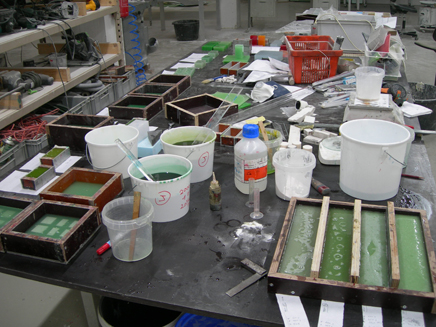
The mess associated with dealing with polyester.
TB: That's a really fantastic story. Let's move on to some more specific questions now: How do you go about choosing materials for a particular project? Is it based on an effect you want to achieve?
VDR: It has a lot to do with scale of course. There's one important scale issue: can you make it a solid model or will it be an open model? I usually prefer the solid model where you can make everything in one block with inserts and floors glued in. Then the materials are usually casting materials. Transparent materials or plaster. And that depends on the level of abstraction also. Usually I try to avoid the more conventional materials that most model makers use like wood and sheets and plastic materials. But there's not really a specific preference.
TB: What made you initially interested in polyester as a medium for your work?
VDR: Because polyester resin casting is really a workshop process, and ever since I was in school, I was looking for things that were not 100% industrial, but almost more craft-based techniques. Polyester fits very well in that range. It's not directly a nice material to work with, but it has a lot of potential, ways to make variations in the techniques to give different colours and transparencies.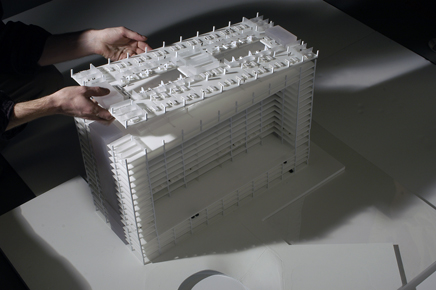
OMA proposal for Dubai. scale 1:200.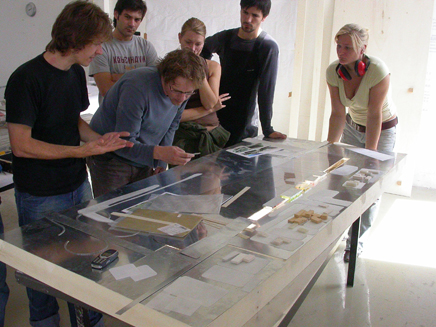
Kuwait Master plan. pictured (left to right) Andrea Bertasi, VDR,
Daniele de Benedictis, Pirjo Haikola, Tomas Libertiny, Tjimtje.
TB: I would say that you have a very particular style of model making. If I were to see a model for the first time somewhere, I would know right away this is a Vincent de Rijk model. Can you speak a little about how you developed this style?
VDR: If you make a drawing, there's two ways of doing it. The technical way, to make sure everything is visible and clear. Or to make something more like a sketch that gives the overall idea. Less detail and more the overall atmosphere - that's also the way to approach the model. I am almost convinced that people who are not able to make a nice sketch, or draw, cannot come up with a nice model. Maybe technically they can, but not as an image.
TB: Your workshop is a very conventional type of workshop with drills and power tools. What kind of specialized equipment do you have?
VDR: Well, I have the stationary milling machine. It was one of the first machines that we bought, because in combination with polyester, we needed to make sharp blocks and cut-outs. Later we added the computer controlled milling machine. Every tool is still basic. There's not much specialty tools. In the beginning, we almost used only hand electrical tools. We still have a lot of those. It's not so much about equipment I think. But the computerized milling machines are of course now more important, there's also the direct link with the drawing.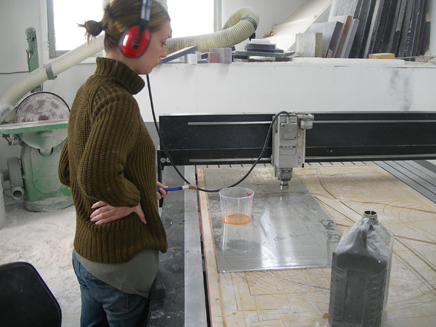
Pirjo operating the CNC routing machine, aluminium being cut with the aid of lubricant.
TB: But even with those sophisticated machines, you've stayed quite basic. If you look at the machines, the software that controls them is the most simple, low-tech software available on the market; whereas there are other products that are more complicated and have more advanced features. Can you comment on why you've stayed with something so basic?
VDR: I'm not sure, but by the instruction of your computer, everything gets more literally linked to what the architect draws. So the parts that come out, are almost exactly like the drawings. And that's what I would most like to avoid. That's why I don't want to have fancy software. It's more about the combination of materials. It's more about thinking in blocks than plates. So I don't really feel the necessity of 3D software. It's basically only for landscapes. And you really limit the types of materials you can use. The nice thing now is that we can use polyester, wood, metals, and even plaster. To keep this sketchy idea as much as possible.
TB: When I was working for you, you stressed time, and time again that we have to re-draw the building at model scale when we get the drawings from the architect. As architects, we're trained to always think about the building at full scale: 1:1. Do you see the building as a model first and foremost?
VDR: Yes. That's important. When you draw out a project in model scale, you start to think about the right dimensions for the materials. If you think about the materials that you can use, it's never accurate to the one-to-one scale because usually the materials are too thick and you have to somehow try to find a way to deal with it. You can only do that in model-scale.
Also, I think in model-scale to avoid the problem of zooming in too much. Even last week, as an example, people came with a drawing, and I had to cut out some 2-D people at a special scale. At the computer, they were worrying about the smallest detail, and I was telling them about the smallest mill bit that we could use (and they were worried about loss of detail). But when you see the result, you realise there's no problem at all. I mean, you can't see the nose of a person at 1:100 scale! It's only this big!
It's a really hard thing to get out of your system if it's not drawn and printed in the right scale. Maybe it's also a generation thing. I never worked with computers when I was starting to design, so everything that you drew, you drew one-to-one. The drawing is a physical thing. You see that also with Rem, he never comments on things he sees on the screen; only on prints, only on things that have a certain size. Size, scale are so important in architecture.
TB: We've talked about this briefly earlier, but what do you see as being your specialty in the model-making world? What keeps OMA, MVRDV, and others coming to make their most important models with you?
VDR: I don't know...I think it's a matter of what they're used to. We have a long term relationship and I know their method of working quite well - especially the hectic nature surrounding it. I'm not behaving directly like a model maker in the process. I know that the architect needs open points in the process and cannot give me any fixed information...it's always half fixed. But still within this process, you have to find starting points - and that is the hard part. Even if they're not ready with the design, you have to give them some model information. It could be made like this or it could be made like that. Then they can make choices already. I think that's what the standard way of making a model is: wait until you get all the drawings and then start. That's what these architects cannot do....and that's what I try to incorporate into the process. Since I've been working with them a long time already, we have developed a system of finding a way to deal with those problems, which most model-makers cannot deal with. So it's not so much that the model itself is so special, it's more the process behind the model...to be able to deal with the process of model-making.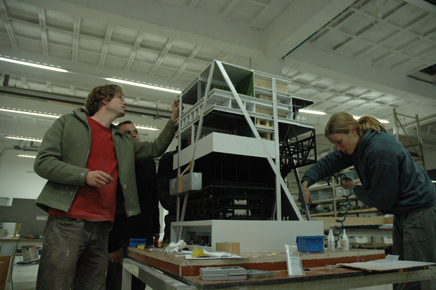
REX Architecture's Dee and Charles Wyly Theatre, Dallas, TX. model 1:50.
TB: Are you exploring any new techniques at the moment or are you focusing on developing existing ideas?
VDR: For me, I cannot really think of new techniques, I think it has never been that way. The techniques are always there and it's what you do with them that makes a model interesting.
TB: What still excites you about model-making?
VDR: The opportunity to build a nice object. And that it's always a challenge. You never know how well things will turn out. If you're into more than sketch models, potentially to make lasting piece, presentation models. They are things that are collected. I feel that I can really be a part of that group...part of a team that produces these special objects. Architecture is still not my specialty at all, but I really respect the way these offices work. And the way they keep things open. Usually there's quite an open minded system to create something really special. That atmosphere I like a lot. Within that process, I feel there's some role that I can play, that makes it always exciting - it's never predictable. You never know what comes out.
TB: Last question: What does the future hold for you? Do you see yourself making models for the next period of time, or do you see yourself transitioning more towards your own products and designs?
VDR: In the near future, I think it will be less about models and more about products and also developing the workshop techniques a little bit further. But at the same time, I also feel very connected to the offices in Rotterdam such as OMA and MVRDV, so perhaps I'll do a few models per year - it would be nice.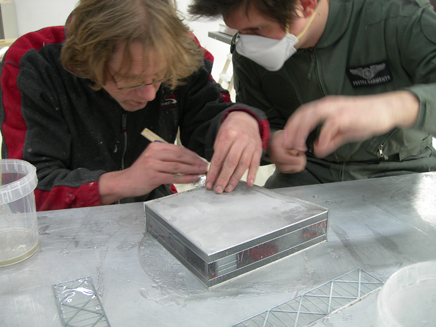
De Rijk and Michele Bruni working on model of REX Architecture's Museum Plaza, Louisville, KY. scale 1:500.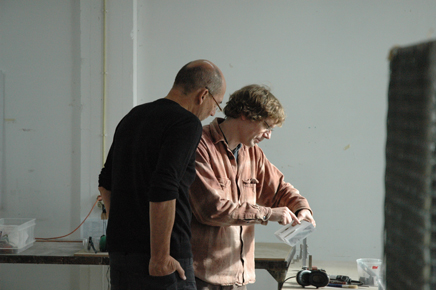
De Rijk and Rem Koolhaas discussing OMA proposal for La Defense Competition.
TB: OK, I guess that concludes the interview. Thanks very much for taking the time to do this Vincent.
VDR: No problem. It was nice.
Tomek Bartczak is a M.Arch candidate in his final year at the University of Toronto . He worked in Vincent's modelshop in 2006-07.
Photographs are by Luca Bendandi, Hans Werlemann and Franz Parthesius.
Special thanks to Evan Saskin and Lukasz Kos.
Creative Commons License
This work is licensed under a Creative Commons License .
/Creative Commons License
11 Comments
Nice to see one of the more important lesser-knowns of contemporary architecture getting some coverage!
vincent work with you was a great experience, i'm sorry for the mess i did, but in the end the model for la defense was amazing with 1000 people only in the last 20 floors... :)
TOMEK my friend i'm really glad to read your interview, i start to remember the old time together...
congratulation VINCENT
Nice interview Tomek! :)
Nice interview.
It brought back great memories of working in Vincent's workshop myself in 2005. I worked with Andrea from the 6th picture, actually. Are you in contact with him, Tomek?
It was a great place to work - so much creativity and precision. Just looking at all the work lying around improved my own model making abilities no end! I'm glad to see Vincent's still going as strong as ever.
All the models for the Tour Phare/La Defense competiton (Which Thom Mayne won) were on display at Trocadero last year...
I don't know if anyone else saw OMA's proposal (first image of the article) but I have to say that the model was absolutely horrendous... It looked like a 1st-year student modeled it.. really rushed. I remember vividly I could not take OMA's proposal seriously because of the lack of craftsmanship...
Tomek, isn't there a rumour that the competition model from La Défense fell and broke, being totally destroyed? Good subject for your interview.
very nice tomek!
thanks again vincent for the amazing period of work at your "werkplaats" :)
the model of la defence destroyed!? .....it is made out of all kind of metal exist on earth!!! ...maybe it bend a little :)
ciao
michele bruni
who is mk2 ??? (2 comments before me) ...... do his making kebab at rotterdam west??? hahahahaha
Tomek, I would die to work for Vincent! I have always loved model making. I studied ID in Montreal and is now running my own design studio in Shanghai. I have my own small workshop where I develop design concepts. This is very rare in China and I am freaking them out a big time being a girl doing a man's job. (this is how backward chinese are in the world of design)...
Do you think Vincent would take me in for 6 months or one year in his workshop?
Angie
You know what, girl?
Those ones who you freaked out are not only chinese but also morons. There are morons everywhere in the world. And it's not that all the chinese are that stupid. And I found it quite stupid when you connected whatever you saw with a nationality of 1.3 billion people.
steve
well, rosswel, you might be right about it. china is indeed opening up and last 2 years I saw much changed in the world of contemporary design. yet it is still a very small group of people in this community. I have traveled in china for 3.5 years intensely due to my previous job requirement. I had to deal with chinese factory face to face. i can assure you that if there is any woman using machinery in a factory, 99% are doing it in order to survive, not because they enjoy it. and that for 1.2billion of people here, none thinks a woman who handles machinery or even a handheld powertool is doing an appropriate job for her. this is the reality. i have talked with some people who studies industrial design in shanghai, girls in the class don't really get to play much with machines. it's usually the technician or the guys who complete their workshop tasks. not because they are not allowed, but because most of them do not want to. well, in fact, there are maybe 2% of women who would study ID anyway.
maybe i am wrong.. i just say what i observed. and keep on with my own destiny. chinese or not, woman or not.
china is sexist from a very old tradition. it is a matter of culture and education. not even mao could change that with the communist ideals of being equal and all that jazz.
one can even see that after spending a few days on vacation. it would be stupid not to notice it after working in the country. and yes there ARE things that are a matter of 1.3 billion people.
Block this user
Are you sure you want to block this user and hide all related comments throughout the site?
Archinect
This is your first comment on Archinect. Your comment will be visible once approved.